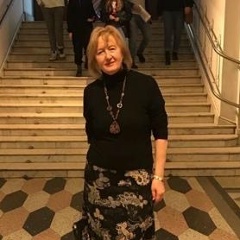В начале войны в Исаакиевском соборе было создано Объединенное хозяйство музеев (ОХМ).
Считалось, что громадный храм и большие подвалы под ним – очень хорошее бомбоубежище. Поэтому сюда свезли из музеев Ленинграда, из пригородных дворцов-музеев уникальные экспонаты, которые не успели эвакуировать.
Книги, ковры, посуда, мебель, изделия из бронзы и фарфора, церковная утварь и многое другое в ящиках всю блокаду сохранялось музейными работниками. Даже позолоченная скульптура с Большого каскада Петергофа!
И рядом с этими ящиками, а часто – даже на них – жили люди. Сотрудники пригородных музеев вернуться домой не могли – дома уже были фашисты. Поэтому остались здесь же, в подвале, в холоде и кромешной темноте. Вместе с детьми.
От бомбежек пострадал водопровод, вода хлынула в подвал. Ее было по щиколотку. Многие ящики всплыли… Для прохода людей постелили настил.
Ребятам, которые там жили, было приказано петь, когда они куда-то идут, чтобы в темноте их случайно не столкнули в ледяную воду… Потому что тогда – болезнь и смерть…
Но люди не «пережидали» там войну. Они выполняли великую МИССИЮ – спасали для нас произведения искусства.
Ведь зимой от холода все промерзало, весной и осенью от высокой влажности все отсыревало, покрывалось плесенью…
Поэтому в редкие солнечные или ветряные дни полуживые, шатающиеся от голода хранители с трудом открывали огромные тяжелые двери, чтобы проветрить собор. Вытаскивали наружу и развешивали между колоннами на веревках ковры, картины, раскладывали книги…
Зрелище, говорят, было живописное. Напоминало восточный базар… Но снаружи этого никто не видел – все было окружено высоким забором… А с первым сигналом воздушной тревоги надо было все быстро занести назад…
Так и жили до самого снятия блокады. Примерно треть сотрудников умерли от холода и голода. Но сохранили для нас ту удивительную красоту, которой мы не устаем любоваться в наших музеях…
Считалось, что громадный храм и большие подвалы под ним – очень хорошее бомбоубежище. Поэтому сюда свезли из музеев Ленинграда, из пригородных дворцов-музеев уникальные экспонаты, которые не успели эвакуировать.
Книги, ковры, посуда, мебель, изделия из бронзы и фарфора, церковная утварь и многое другое в ящиках всю блокаду сохранялось музейными работниками. Даже позолоченная скульптура с Большого каскада Петергофа!
И рядом с этими ящиками, а часто – даже на них – жили люди. Сотрудники пригородных музеев вернуться домой не могли – дома уже были фашисты. Поэтому остались здесь же, в подвале, в холоде и кромешной темноте. Вместе с детьми.
От бомбежек пострадал водопровод, вода хлынула в подвал. Ее было по щиколотку. Многие ящики всплыли… Для прохода людей постелили настил.
Ребятам, которые там жили, было приказано петь, когда они куда-то идут, чтобы в темноте их случайно не столкнули в ледяную воду… Потому что тогда – болезнь и смерть…
Но люди не «пережидали» там войну. Они выполняли великую МИССИЮ – спасали для нас произведения искусства.
Ведь зимой от холода все промерзало, весной и осенью от высокой влажности все отсыревало, покрывалось плесенью…
Поэтому в редкие солнечные или ветряные дни полуживые, шатающиеся от голода хранители с трудом открывали огромные тяжелые двери, чтобы проветрить собор. Вытаскивали наружу и развешивали между колоннами на веревках ковры, картины, раскладывали книги…
Зрелище, говорят, было живописное. Напоминало восточный базар… Но снаружи этого никто не видел – все было окружено высоким забором… А с первым сигналом воздушной тревоги надо было все быстро занести назад…
Так и жили до самого снятия блокады. Примерно треть сотрудников умерли от холода и голода. Но сохранили для нас ту удивительную красоту, которой мы не устаем любоваться в наших музеях…
At the beginning of the war in St. Isaac's Cathedral was created the United Museum Economy (UHM).
It was believed that the huge temple and the large cellars below it were a very good bomb shelter. Therefore, unique exhibits were brought here from the museums of Leningrad, from suburban palaces-museums, which they did not manage to evacuate.
Books, carpets, dishes, furniture, bronze and porcelain items, church utensils and much more were kept in boxes by museum workers throughout the blockade. Even a gilded sculpture from the Grand Cascade of Peterhof!
And next to these boxes, and often - even on them - people lived. Employees of suburban museums could not return home - the Nazis were already at home. Therefore, they remained here, in the basement, in the cold and pitch darkness. Together with children.
The water supply was damaged by the bombing, water rushed into the basement. She was ankle-deep. Many boxes have surfaced ... For the passage of people, the flooring was laid.
The children who lived there were ordered to sing when they go somewhere, so that in the dark they would not be accidentally pushed into the icy water ... Because then - sickness and death ...
But people did not "wait out" the war there. They fulfilled a great MISSION - they saved works of art for us.
After all, in winter everything froze through the cold, in spring and autumn everything became damp from high humidity, covered with mold ...
Therefore, on rare sunny or windy days, half-dead, reeling from hunger, the guardians with difficulty opened the huge heavy doors to ventilate the cathedral. They dragged out and hung carpets, paintings on ropes between the columns, laid out books ...
The sight, they say, was picturesque. It looked like an oriental bazaar ... But no one saw it outside - everything was surrounded by a high fence ... And with the first air raid signal, everything had to be brought back quickly ...
So they lived until the lifting of the blockade. About a third of the employees died of cold and hunger. But they have preserved for us that amazing beauty that we never tire of admiring in our museums ...
It was believed that the huge temple and the large cellars below it were a very good bomb shelter. Therefore, unique exhibits were brought here from the museums of Leningrad, from suburban palaces-museums, which they did not manage to evacuate.
Books, carpets, dishes, furniture, bronze and porcelain items, church utensils and much more were kept in boxes by museum workers throughout the blockade. Even a gilded sculpture from the Grand Cascade of Peterhof!
And next to these boxes, and often - even on them - people lived. Employees of suburban museums could not return home - the Nazis were already at home. Therefore, they remained here, in the basement, in the cold and pitch darkness. Together with children.
The water supply was damaged by the bombing, water rushed into the basement. She was ankle-deep. Many boxes have surfaced ... For the passage of people, the flooring was laid.
The children who lived there were ordered to sing when they go somewhere, so that in the dark they would not be accidentally pushed into the icy water ... Because then - sickness and death ...
But people did not "wait out" the war there. They fulfilled a great MISSION - they saved works of art for us.
After all, in winter everything froze through the cold, in spring and autumn everything became damp from high humidity, covered with mold ...
Therefore, on rare sunny or windy days, half-dead, reeling from hunger, the guardians with difficulty opened the huge heavy doors to ventilate the cathedral. They dragged out and hung carpets, paintings on ropes between the columns, laid out books ...
The sight, they say, was picturesque. It looked like an oriental bazaar ... But no one saw it outside - everything was surrounded by a high fence ... And with the first air raid signal, everything had to be brought back quickly ...
So they lived until the lifting of the blockade. About a third of the employees died of cold and hunger. But they have preserved for us that amazing beauty that we never tire of admiring in our museums ...
У записи 7 лайков,
2 репостов,
445 просмотров.
2 репостов,
445 просмотров.
Эту запись оставил(а) на своей стене Евгений Марон



























